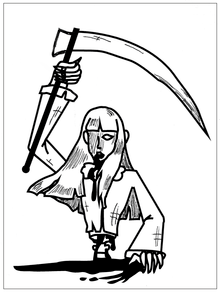Teke Teke

The Teke Teke is a Japanese urban legend about the ghost of a young woman, or school girl, who fell on a railway line and was cut in half by the oncoming train. Now a vengeful spirit (Onryō), she travels on either her hand or elbows, her dragging upper torso making a scratching or 'teke teke' sound. If she encounters anyone at night and the victim is not fast enough, she will slice them in half at the torso, mimicking her own disfigurement.[1]
Legend
As a young school boy was walking home at night, he spotted a beautiful young girl standing by a windowsill resting on her elbows. They smiled at each other for a moment. The boy wondered what a girl was doing in an all-boys school, but before he could wonder more about the girl she jumped out of the window and revealed her lower half was missing. Frightened, he stood in the sidewalk, but before he could run, she cut the boy in half and the boy was found dead but his lower half was missing.[2]
A very similar urban legend concerns another girl, Kashima Reiko, who died on the train tracks and lost her legs. Kashima Reiko, appears to be an abbreviation of Kamen Shinin Ma (Mask, dead person demon). Kashima haunts bathroom stalls and will ask the occupant where her legs are. If the occupant answers incorrectly, she will rip their legs off. To be saved, they must tell her that her legs are at the Meishin Railway and answer Kashima Reiko if she asks who told them this. Sometimes she will ask people what her name is, which is a trick question. Answering "Kashima Reiko" will result in her attacking them. The correct answer is "Mask Death Demon", derived from the meaning of her name.[3] In one area of Japan, a statue of rice straw called Kashima-sama was made in order to protect the village from bad influence, and seems that residents call its name in order to expulse of an evil spirit. However, when it was transmitted to other areas,"-sama" changed into "-san" and it seems that it was mistaken as an evil spirit name of female or a wounded soldier who worshiped the Kashima Shrine.[4]
See also
- Aka Manto
- Hanako-san (Friday the 13th)
- Kuchisake-onna "Kashima Reiko" is also said to be her real name.[5]
- List of ghosts
- Sadako Yamamura
References
- ↑ de Vos, Gail (June 26, 2012). What Happens Next? Contemporary Urban Legends and Popular Culture. ABC-CLIO. p. 170. ISBN 978-1598846348. Retrieved 22 August 2017.
- ↑ Q, Yuri (18 July 2014). Ghost of Japan Short Stories. Lulu Press, Inc. ISBN 978-1312365131. Retrieved 22 August 2017.
- ↑ Bathroom Readers, Institute (2017-09-12). Uncle John's OLD FAITHFUL 30th Anniversary Bathroom Reader. Bathroom Readers' Institute. Simon and Schuster. ISBN 9781684121267. Retrieved May 6, 2018.
- ↑ Jones, Michael (1995). Folkloristics: An Introduction. Michael Owen Jones. Indiana University Press. ISBN 9780253329349. Retrieved May 6, 2018.
- ↑ Hatsumi, Ken-ichi (November 2012). ぼくらの昭和オカルト大百科: 70年代オカルトブーム再考. 初見健一. OZORA Publishing Company. ISBN 9784903175416. Retrieved May 3, 2018.